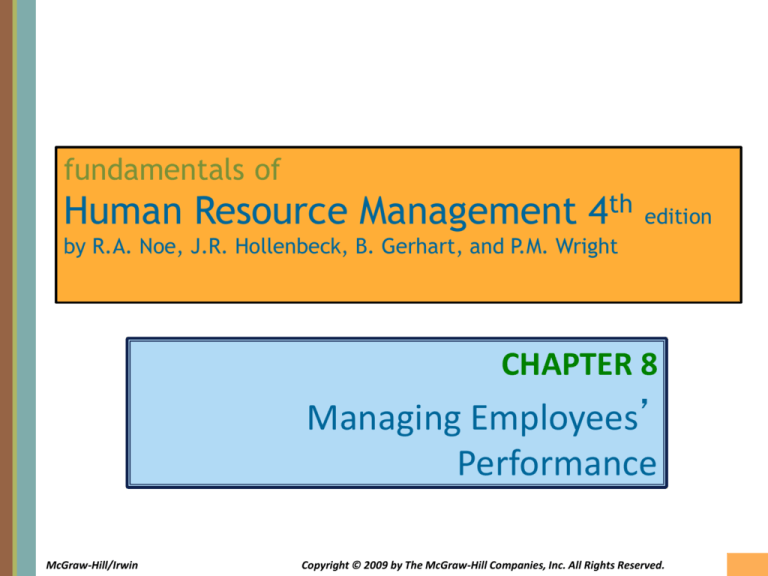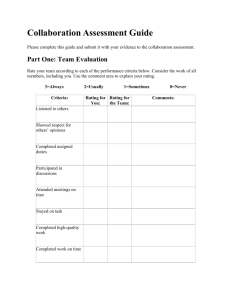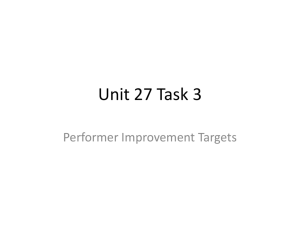
fundamentals of
Human Resource Management 4th
edition
by R.A. Noe, J.R. Hollenbeck, B. Gerhart, and P.M. Wright
CHAPTER 8
Managing Employees’
Performance
McGraw-Hill/Irwin
Copyright © 2009 by The McGraw-Hill Companies, Inc. All Rights Reserved.
8-1
Figure 8.1: Stages of the Performance
Management Process
8-2
Table 8.1:
Basic Approaches to Performance
Measurement
8-3
Measuring Performance:
Making Comparisons
Simple Ranking
• Requires
managers to
rank
employees in
their group
from the
highest
performer to
the poorest
performer.
Forced
Distribution
• Assigns a
certain
percentage of
employees to
each category
in a set of
categories.
Paired
Comparison
• Compares
each employee
with each
other
employee to
establish
rankings.
8-4
Measuring Performance:
Rating Individuals - Attributes
Graphic Rating Scale
• Lists traits and provides a
rating scale for each trait.
• The employer uses the scale
to indicate the extent to
which an employee displays
each trait.
Mixed-Standard Scale
• Uses several statements
describing each trait to
produce a final score for
that trait.
8-5
Measuring Performance:
Rating Individuals - Behaviors
Critical-Incident Method
• Based on managers’ records
of specific examples of the
employee acting in ways that
are either effective or
ineffective.
• Employees receive feedback
about what they do well and
what they do poorly and how
they are helping the
organization achieve its
goals.
Behaviorally Anchored Rating
Scale (BARS)
• Rates behavior in terms of a
scale showing specific
statements of behavior that
describe different levels of
performance.
8-6
Measuring Performance:
Rating Individuals – Behaviors (continued)
Behavioral Observation Scale
(BOS)
• A variation of a BARS which
uses all behaviors necessary
for effective performance to
rate performance at a task.
• A BOS also asks the
manager to rate the
frequency with which the
employee has exhibited the
behavior during the rating
period.
Organizational Behavior
Modification (OBM)
• A plan for managing the
behavior of employees
through a formal system of
feedback and
reinforcement.
8-7
Measuring Performance:
Measuring Results
• Management by Objectives (MBO): people at
each level of the organization set goals in a
process that flows from top to bottom, so that
all levels are contributing to the
organization’s overall goals.
• These goals become the standards for
evaluating each employee’s performance.
8-8
Sources of Performance Information
• 360-Degree Performance Appraisal:
performance measurement that combines
information from the employees’:
– Managers
– Peers
– Subordinates
– Self
– Customers
8-9
Types of Performance Measurement
Rating Errors
• Contrast errors: the rater compares an
individual, not against an objective standard,
but against other employees.
• Distributional errors: the rater tends to use
only one part of a rating scale.
– Leniency: the reviewer rates everyone near the top
– Strictness: the rater favors lower rankings
– Central tendency: the rater puts everyone near the
middle of the scale
8-10
Political Behavior in Performance
Appraisals
• Distorting a performance evaluation to
advance one’s personal goals
• A technique to minimize appraisal politics is a
calibration meeting:
– Meeting at which managers discuss employee
performance ratings and provide evidence
supporting their ratings with the goal of
eliminating the influence of rating errors
8-11
Giving Performance Feedback
• Scheduling Performance Feedback
– Performance feedback should be a regular, expected
management activity.
– Annual feedback is not enough.
– Employees should receive feedback so often that they
know what the manager will say during their annual
performance review.
• Preparing for a Feedback Session
– Managers should be prepared for each formal feedback
session.
8-12
Figure 8.7: Improving Performance
8-13
Legal and Ethical Issues in
Performance Management
• Legal
– Performance management processes are often
scrutinized in cases of discrimination or dismissal.
• Ethical
– Employee monitoring via electronic devices and
computers may raise concerns over employee
privacy.
8-14
Summary
• Performance management is the process through
which managers ensure that employees’ activities
and outputs contribute to the organization’s goals.
• Organizations establish performance management
systems to meet three broad purposes:
– Strategic purpose
– Administrative purpose
– Developmental purpose
• Performance measures should fit with the
organization’s strategy by supporting its goals and
culture.
8-15








